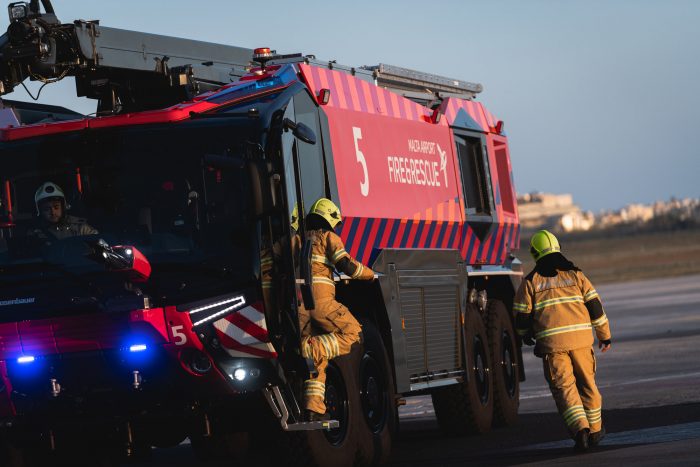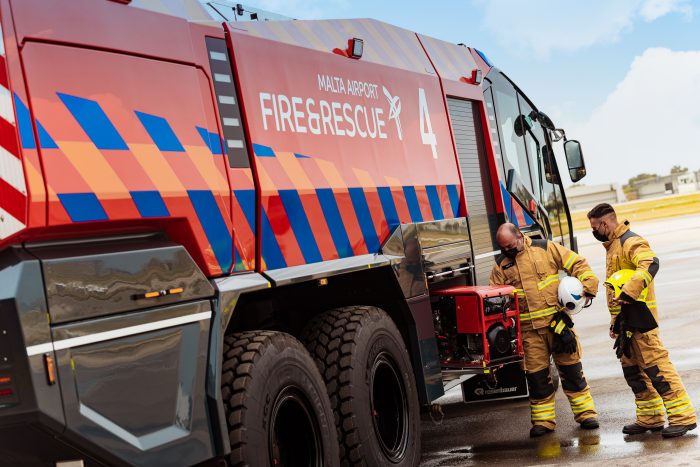Fire and Rescue
Aircraft accidents and incidents are very rare events but due to the nature of flight operations, nearly 90% of them occur at or near an aerodrome, although, most of such occurrences are not related directly to any aerodrome safety issue.
As soon as pilots suspect something is wrong with the aircraft they will attempt to land at the nearest suitable aerodrome. The International Civil Aviation Organisation (ICAO) mandates that any aerodrome handling commercial traffic must provide Rescue and Fire Fighting Services (RFFS) to save lives in the event of an aircraft accident or incident.
ICAO Standards
ICAO considers RFFS so important that the topic forms part of Annex 14 to the Chicago Convention and is further amplified in the Airport Planning Manual. Extremely detailed standards are then specified in Document 9137 Airport Services which dedicates the whole of Part 1 (over 230 pages) to Rescue and Fire Fighting Services. The ICAO documents specify the level of protection to be provided at an airport, vehicle and extinguishing agent characteristics, siting of fire stations, training of personnel and operating procedures for dealing with an emergency.
One important requirement concerns the response time. The Airport Planning Manual is quite prescriptive on this matter where it states that the airport fire station should be located at a place that ensures that the response times for aircraft accidents and incidents are two minutes, and do not exceed three minutes, to the end of each runway in optimum visibility and surface conditions.
Each airport falls within a particular Crash Category which specifies the equipment, amount of extinguishing agents and number of vehicles and personnel that have to be available at the aerodrome. The airport Crash Category is determined by the size of the largest aircraft operating regularly at that particular airfield. Malta Airport is a Category 9 airport, meaning that the MIA RFFS are capable of handling aircraft as large as the Airbus A330/A340 or Boeing B777, which visit the Island regularly.
The Fleet
The Rescue and Firefighting Services (RFFS) are equipped with a compliment of 9 vehicles, which allow the team to handle any situation ranging from fires and fuel spills to recue operations.
The firefighting fleet consists of three major foam vehicles having two variants, with the larger one being the Rosenbauer Panther A148 8X8 Piercer and the other two being the Rosenbauer Panther A146 6×6. In addition to these, a designated domestic firefighting vehicle, the Rosenbauer MAN RIV, is housed within the station which is deployed when required on the airport campus.
Technical Details for the Rosenbauer A148 8X8

| Water Tank Capacity | 15,000 litres |
| Foam Tank (AFFF) | 1,800 litres |
| Pump Output | 10,000 l/min @ 10 bar |
| Roof Turret | High-reach extendable Rosenbauer RM 65 turret with piercing tool |
| Performance | Full output 6,000 l/min @ 10 bar |
| Jet Throw | Approx. 90m with full output, approx. 65m with reduced output |
| Bumper Turret | Rosenbauer RM 15 |
| Performance | 2,000 l/min @ 10 bar |
| Jet Throw | 60m full jet |
| Chassis | Rosenbauer 52.1450 |
| Engine | 2 units – Volvo D16K750 – Top Speed: 135 km/h |
| Gear Box | 6 speed with crawling speed & reverse gear, fully automatic |
| Dimensions | Length: 13,100mm, Width: 3,000mm, Height: 4,000mm |
| Gross Vehicle Weight | 52,000 kg |
Technical Details for the Rosenbauer A146 6X6

| Water Tank Capacity | 12,500 litres |
| Foam Tank (AFFF) | 1,500 litres |
| Pump Output | 9,000 l/min @ 10 bar |
| Roof Turret | Rosenbauer RM 80 |
| Performance | 6,000 l/min @ 14.3 bar |
| Jet Throw | 85m full jet |
| Bumper Turret | Rosenbauer RM 80 |
| Performance | 2,000 l/min @ 16.5 bar |
| Jet Throw | 60m full jet |
| Chassis | Rosenbauer 39.750 |
| Engine | Volvo D16K750 |
| Gear Box | 8 speed & reverse gear, fully automatic |
| Dimensions | Length: 10,790mm, Width: 3,000mm, Height: 3,650mm |
| Gross Vehicle Weight | 39,000 kg |
Technical Details for the Rosenbauer MAN 4×4
| Water Tank Capacity | 2,500 litres |
| Foam Tank (AFFF) | 300 litres |
| Pump Output | 3,200 l/min @ 10 bar |
| Roof Turret | Rosenbauer RM 25 C |
| Performance | 2,500 l/min @ 12 bar |
| Jet Throw | 70m full jet |
| Bumper Turret | Rosenbauer RM 15 C |
| Performance | 1,550 l/min |
| Jet Throw | 46m full jet |
| Chassis | MAN 18.540 TGS |
| Engine | D2676LF09 Euro 5 |
| Gear Box | ZF12AS 2330 OD MAN TipMatik |
| Dimensions | Length: 7,850mm, Width: 2,500mm, Height: 3,870mm |
| Gross Vehicle Weight | 18,000 kg |
Auxiliary Support Vehicles
| Crash 1 Rapid Intervention Vehicle | Mitsubishi L200 with high-pressure pump (500 litres) |
| Crash 6 Multipurpose Vehicle | Peugeot Partner |
| Crash 7 Executive – RFFS Vehicle | Mitsubishi L200 |
| Crash 8 Personnel Transport Vehicle | Ford Transit (passenger van variant) |
| Crash 9 Washdown & Back-up Mobile Command Unit | Iveco Daily Heavy Duty |

